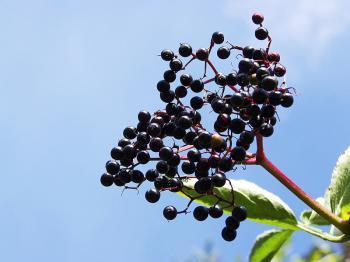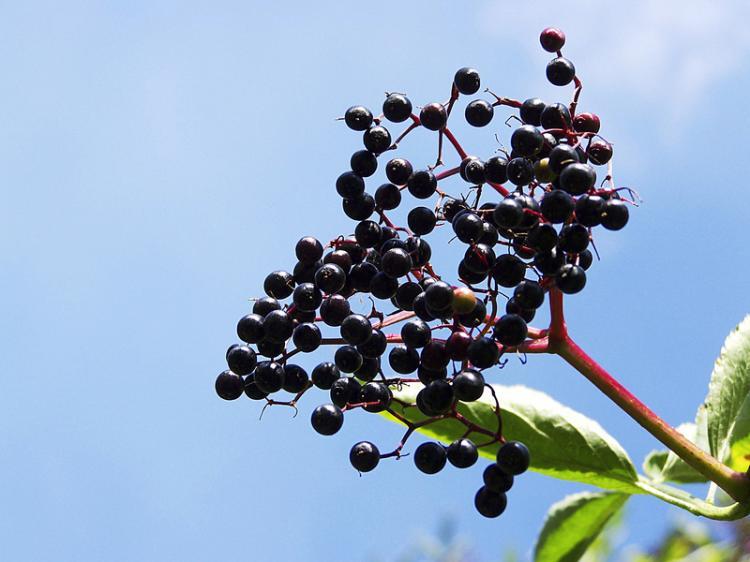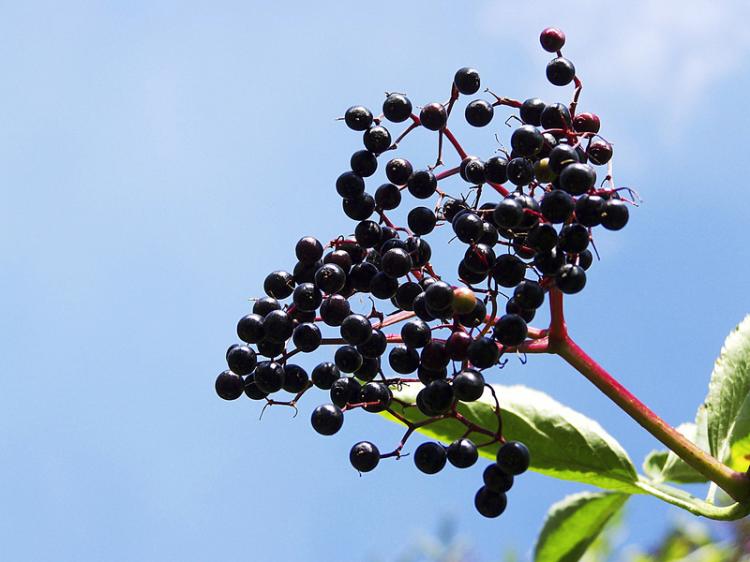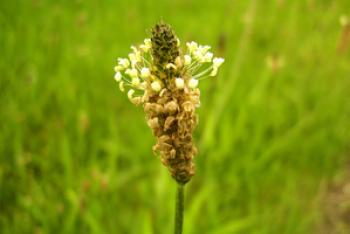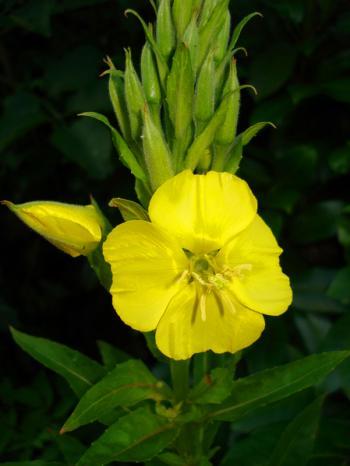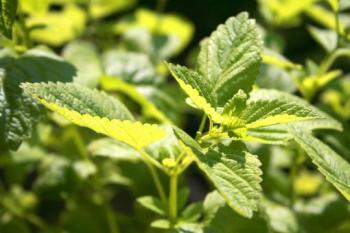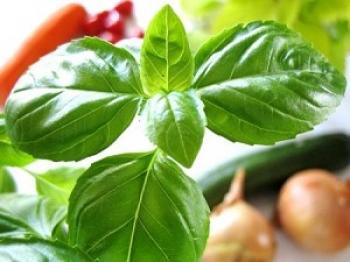Late summer is the perfect time to harvest elderberries and make delicious jam. The plant, (Sambucus nigra in Latin) is easily identifiable by its shiny black-violet berries. Despite the tantalizing appearance of the berries on the vine, it is a good idea not to eat the berries raw: they are not digestible, and would cause considerable abdominal discomfort. Cooking the berries, however, destroys the compound solanine, which causes the discomfort.
The wood of elderberry is light and airy. It is easy to remove the marrow when the wood is fresh. Punching some holes into the hollow stems and tying a few of the stems together creates a delightful wind-chime. The Romans called the hollowed-out stems “sambucus.”
The dark, juicy elderberries are a stark contrast to the fragrant, crème-colored blossoms that adorn the bushes in May. One can prepare sparkling elderberry wine from the berries. To prepare the wine, you will first have to wait for sunny harvest weather, as the yeast necessary for the fermentation process is found in the pollen. An easy, sparkling wine recipe is made by taking twenty generous blossoms and eight liters of water, one kilogram of sugar, 30 grams of citric acid and two whole lemons, cubed. Cover the container with a towel and let the concoction sit at an even temperature. Stir every so often, and filter after three or four days (a tea sieve will work very well for this). The bottles will have to be very strong to withstand the enormous pressure that will build within a few days from the fermentation process. I like to use plastic soft-drink bottles. Six weeks later, you will have a sparkling summer drink to enjoy, with a content of about 6 percent alcohol.
You can also fry the blossoms with pancake dough in oil. Tea prepared from the blossoms is effective against colds. Adding the blossoms to bathwater will help calm the nerves. You can also make an ointment from fresh elderberries, or even vinegar from the blossoms. To make vinegar, place the blossoms without their stems into white wine vinegar. Strain the blossoms out after four weeks, and use the vinegar on summer salads.
Not everyone likes the distinctive smell of dried elderberry blossoms. However, to get back to the berries: a good way to turn them into juice is to take off the stems and heat the berries slowly, until the peel cracks open. At this point, it is possible to strain the berries. The juice should then be boiled with a little sugar and poured into bottles previously rinsed with hot water. Alternatively, you can use canning sugar and turn everything into a nice jelly. You can also still harvest the berries after they have dried on the bush, saving yourself a step, because dried berries do not need to be heated. The berries can be added directly to muesli (a fruit and wholegrain breakfast cereal). It should be noted that pregnant or lactating women should not use elderberries in certain forms.
In olden times, every house and cottage had an elderberry bush in the back. It was a commonly held belief that “Frau Holle” (Mother Hulda or Mother Holle, a benign spirit spoken about in The Brothers Grimm Fairytales) dwelt amongst its boughs, and the bushes were never trimmed or cut off without good reason.
Elisabeth Horbach is a botanical tour guide.
Her Web site is elisabeth-horbach.de
Original Article in Germany: epochtimes.de/articles/2008/09/02/334027.html
The wood of elderberry is light and airy. It is easy to remove the marrow when the wood is fresh. Punching some holes into the hollow stems and tying a few of the stems together creates a delightful wind-chime. The Romans called the hollowed-out stems “sambucus.”
The dark, juicy elderberries are a stark contrast to the fragrant, crème-colored blossoms that adorn the bushes in May. One can prepare sparkling elderberry wine from the berries. To prepare the wine, you will first have to wait for sunny harvest weather, as the yeast necessary for the fermentation process is found in the pollen. An easy, sparkling wine recipe is made by taking twenty generous blossoms and eight liters of water, one kilogram of sugar, 30 grams of citric acid and two whole lemons, cubed. Cover the container with a towel and let the concoction sit at an even temperature. Stir every so often, and filter after three or four days (a tea sieve will work very well for this). The bottles will have to be very strong to withstand the enormous pressure that will build within a few days from the fermentation process. I like to use plastic soft-drink bottles. Six weeks later, you will have a sparkling summer drink to enjoy, with a content of about 6 percent alcohol.
You can also fry the blossoms with pancake dough in oil. Tea prepared from the blossoms is effective against colds. Adding the blossoms to bathwater will help calm the nerves. You can also make an ointment from fresh elderberries, or even vinegar from the blossoms. To make vinegar, place the blossoms without their stems into white wine vinegar. Strain the blossoms out after four weeks, and use the vinegar on summer salads.
Not everyone likes the distinctive smell of dried elderberry blossoms. However, to get back to the berries: a good way to turn them into juice is to take off the stems and heat the berries slowly, until the peel cracks open. At this point, it is possible to strain the berries. The juice should then be boiled with a little sugar and poured into bottles previously rinsed with hot water. Alternatively, you can use canning sugar and turn everything into a nice jelly. You can also still harvest the berries after they have dried on the bush, saving yourself a step, because dried berries do not need to be heated. The berries can be added directly to muesli (a fruit and wholegrain breakfast cereal). It should be noted that pregnant or lactating women should not use elderberries in certain forms.
In olden times, every house and cottage had an elderberry bush in the back. It was a commonly held belief that “Frau Holle” (Mother Hulda or Mother Holle, a benign spirit spoken about in The Brothers Grimm Fairytales) dwelt amongst its boughs, and the bushes were never trimmed or cut off without good reason.
Elisabeth Horbach is a botanical tour guide.
Her Web site is elisabeth-horbach.de
Original Article in Germany: epochtimes.de/articles/2008/09/02/334027.html

